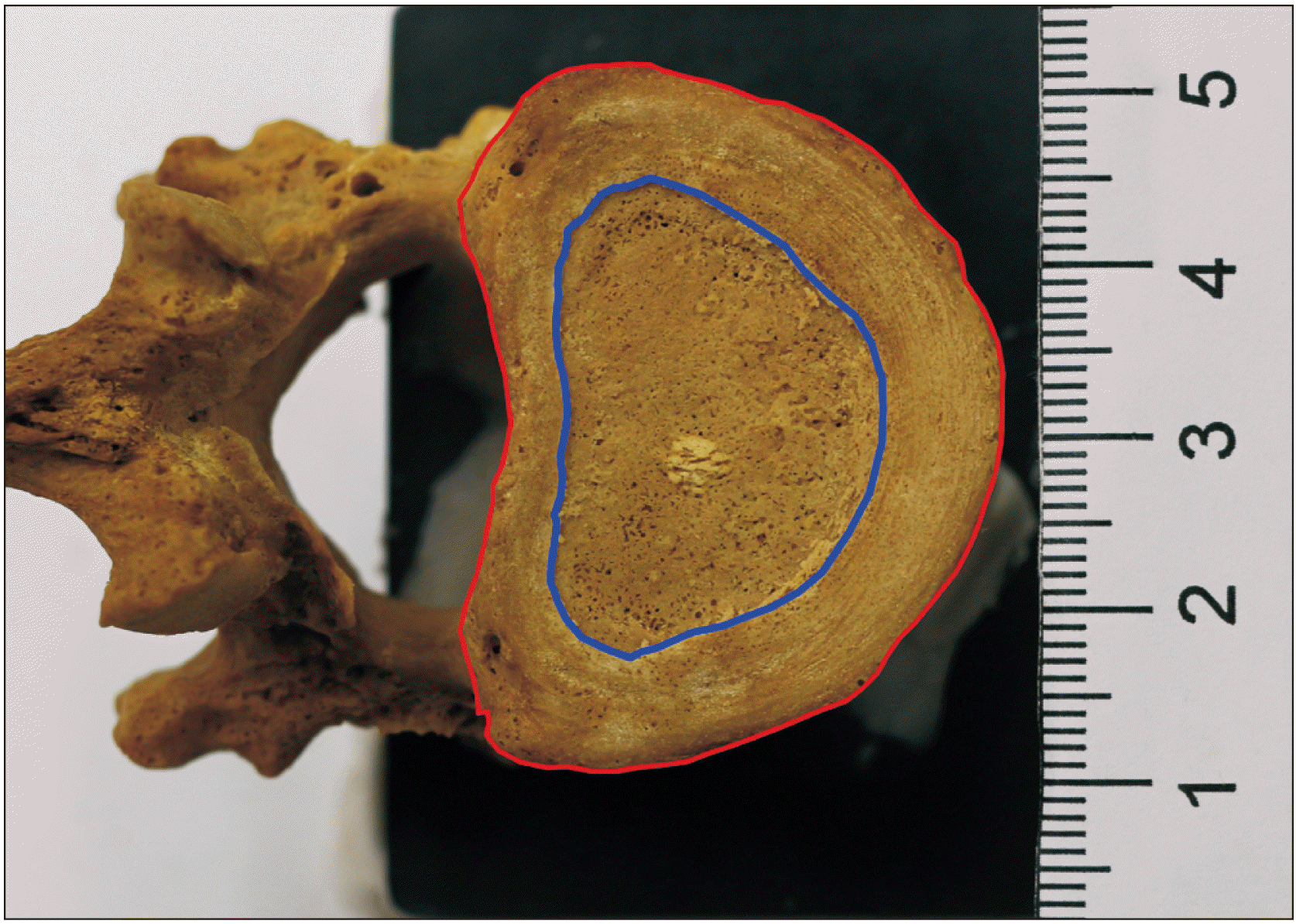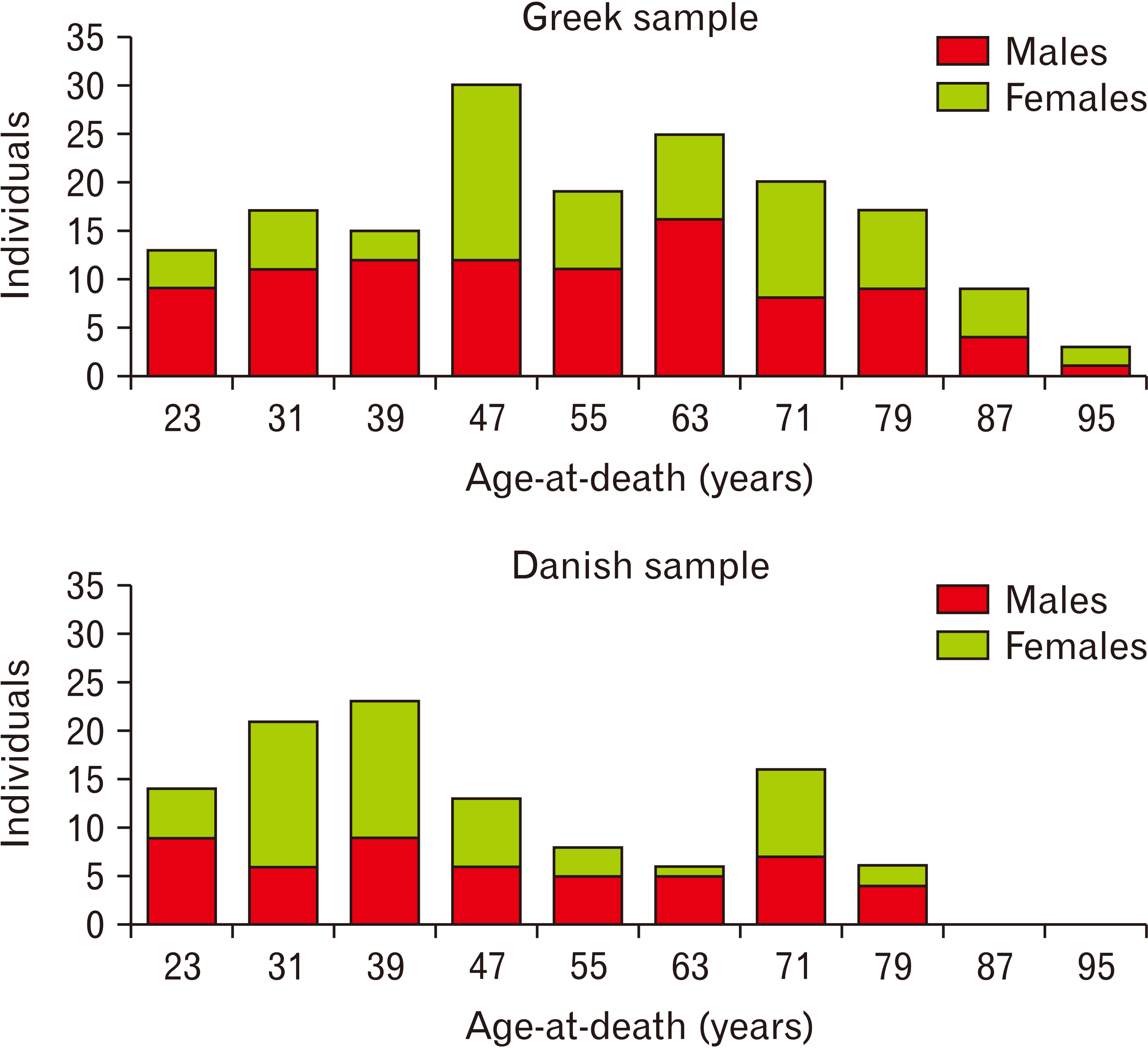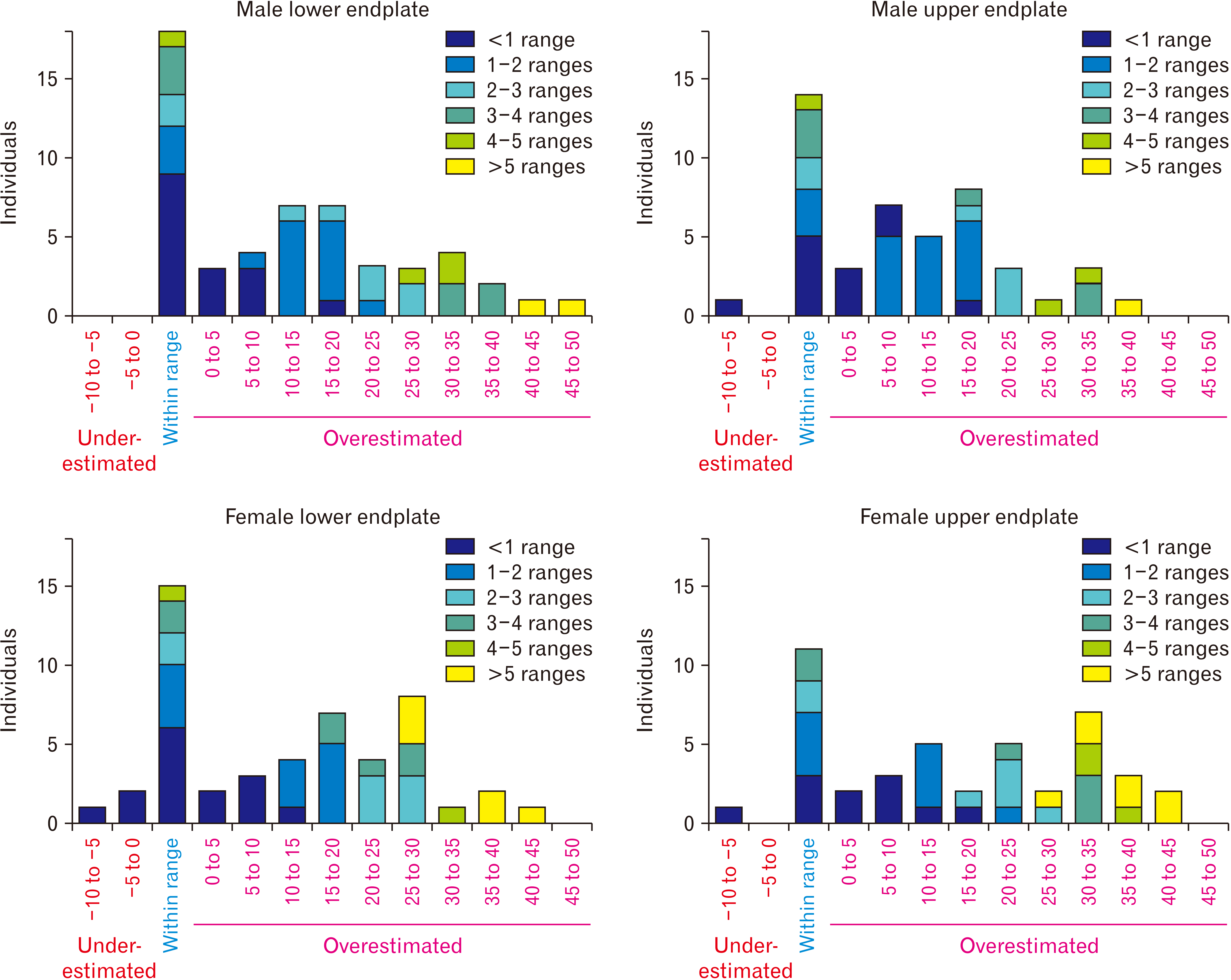1. Cunha E, Baccino E, Martrille L, Ramsthaler F, Prieto J, Schuliar Y, Lynnerup N, Cattaneo C. 2009; The problem of aging human remains and living individuals: a review. Forensic Sci Int. 193:1–13. DOI:
10.1016/j.forsciint.2009.09.008. PMID:
19879075.
2. İşcan MY, Steyn M. 2013. The human skeleton in forensic medicine. 3rd ed. Charles C Thomas Publisher;Springfield: p. 493. DOI:
10.1016/j.forsciint.2009.09.008.
3. Meindl RS, Lovejoy CO. 1985; Ectocranial suture closure: a revised method for the determination of skeletal age at death based on the lateral-anterior sutures. Am J Phys Anthropol. 68:57–66. DOI:
10.1002/ajpa.1330680106. PMID:
4061602.
4. Smith SL, Buschang PH. 2004; Variation in longitudinal diaphyseal long bone growth in children three to ten years of age. Am J Hum Biol. 16:648–57. DOI:
10.1002/ajhb.20077. PMID:
15495231.
5. Kagerer P, Grupe G. 2001; Age-at-death diagnosis and determination of life-history parameters by incremental lines in human dental cementum as an identification aid. Forensic Sci Int. 118:75–82. DOI:
10.1016/S0379-0738(00)00382-0. PMID:
11343858.
6. Lovejoy CO. 1985; Dental wear in the Libben population: its functional pattern and role in the determination of adult skeletal age at death. Am J Phys Anthropol. 68:47–56. DOI:
10.1002/ajpa.1330680105. PMID:
4061601.
7. Parra RC, Suárez-Ponce DG, Escalante-Flórez KJ, Condori LA, Calcina-Mendoza O, Peralta-Cerro LM, Rosas-Moyano GA. 2021; Age-at-death estimation in adults and verification of a forensic international methodology using single-rooted teeth: an approach for a Peruvian context. Forensic Sci Int Rep. 3:100176. DOI:
10.1016/j.fsir.2021.100176.
8. Buckberry JL, Chamberlain AT. 2002; Age estimation from the auricular surface of the ilium: a revised method. Am J Phys Anthropol. 119:231–9. DOI:
10.1002/ajpa.10130. PMID:
12365035.
9. Lovejoy CO, Meindl RS, Pryzbeck TR, Mensforth RP. 1985; Chronological metamorphosis of the auricular surface of the ilium: a new method for the determination of adult skeletal age at death. Am J Phys Anthropol. 68:15–28. DOI:
10.1002/ajpa.1330680103. PMID:
4061599.
10. Meindl RS, Lovejoy CO, Mensforth RP, Walker RA. 1985; A revised method of age determination using the os pubis, with a review and tests of accuracy of other current methods of pubic symphyseal aging. Am J Phys Anthropol. 68:29–45. DOI:
10.1002/ajpa.1330680104. PMID:
4061600.
11. DiGangi EA, Bethard JD, Kimmerle EH, Konigsberg LW. 2009; A new method for estimating age-at-death from the first rib. Am J Phys Anthropol. 138:164–76. DOI:
10.1002/ajpa.20916. PMID:
18711740.
12. İşcan MY, Loth SR, Wright RK. 1984; Metamorphosis at the sternal rib end: a new method to estimate age at death in white males. Am J Phys Anthropol. 65:147–56. DOI:
10.1002/ajpa.1330650206. PMID:
6507605.
13. Nikita E. 2013; Quantitative assessment of the sternal rib end morphology and implications for its application in aging human remains. J Forensic Sci. 58:324–9. DOI:
10.1111/1556-4029.12047. PMID:
23278810.
14. Milner GR, Boldsen JL, Ousley SD, Getz SM, Weise S, Tarp P. 2022. Transition Analysis 3, version 0.8.4. [Software]. Available from:
https://statsmachine.net/software/TA3/. accessed 2022 Mar 15.
15. Milner GR, Boldsen JL. 2012; Transition analysis: a validation study with known-age modern American skeletons. Am J Phys Anthropol. 148:98–110. DOI:
10.1002/ajpa.22047. PMID:
22419394.
16. Snodgrass JJ. 2004; Sex differences and aging of the vertebral column. J Forensic Sci. 49:458–63. DOI:
10.1520/JFS2003198. PMID:
15171159.
17. Stewart TD. 1958. Rate of development of vertebral osteoarthritis in American whites and its significance in skeletal age identification. Leech;Tallahassee: DOI:
10.1520/jfs2003198.
18. Watanabe S, Terazawa K. 2006; Age estimation from the degree of osteophyte formation of vertebral columns in Japanese. Leg Med (Tokyo). 8:156–60. DOI:
10.1016/j.legalmed.2006.01.001. PMID:
16621650.
19. Van der Merwe AE, Işcan MY, L'Abbè EN. 2006; The pattern of vertebral osteophyte development in a South African population. Int J Osteoarchaeol. 16:459–64. DOI:
10.1002/oa.841.
21. Praneatpolgrang S, Prasitwattanaseree S, Mahakkanukrauh P. 2019; Age estimation equations using vertebral osteophyte formation in a Thai population: comparison and modified osteophyte scoring method. Anat Cell Biol. 52:149–160. DOI:
10.5115/acb.2019.52.2.149. PMID:
31338232. PMCID:
PMC6624338.
23. Goh S, Price RI, Song S, Davis S, Singer KP. 2000; Magnetic resonance-based vertebral morphometry of the thoracic spine: age, gender and level-specific influences. Clin Biomech (Bristol, Avon). 15:417–25. DOI:
10.1016/S0268-0033(99)00100-X. PMID:
10771120.
24. Rühli FJ, Müntener M, Henneberg M. 2005; Age-dependent changes of the normal human spine during adulthood. Am J Hum Biol. 17:460–9. DOI:
10.1002/ajhb.20403. PMID:
15981187.
25. Saadat Mostafavi SR, Memarian A, Motamedi O, Mohamadi nejad khanamani M, Khaleghi M, Habibi S. 2021; Fourth lumbar vertebral parameters in predicting the gender, height and age in Iranian population. Forensic Sci Int Rep. 3:100175. DOI:
10.1016/j.fsir.2021.100175.
27. Buikstra JE, Ubelaker DH. 1994. Standards for data collection from human skeletal remains: proceedings of a Seminar at The Field Museum of Natural History. Arkansas Archeological Survey;Fayetteville: DOI:
10.1016/j.jchb.2006.10.003.
28. Perini TA, de Oliveira GL, dos Santos Ornellas J, de Oliveira FP. 2005; Technical error of measurement in anthropometry. Rev Bras Med Esporte. 11:86–90. DOI:
10.1590/S1517-86922005000100009.
29. Garoufi N, Bertsatos A, Chovalopoulou ME, Villa C. 2020; Forensic sex estimation using the vertebrae: an evaluation on two European populations. Int J Legal Med. 134:2307–18. DOI:
10.1007/s00414-020-02430-w. PMID:
32940842.
30. Prentice A, Schoenmakers I, Laskey MA, de Bono S, Ginty F, Goldberg GR. 2006; Nutrition and bone growth and development. Proc Nutr Soc. 65:348–60. DOI:
10.1079/PNS2006519. PMID:
17181901. PMCID:
PMC2039894.
31. Ruff C. 2018. Skeletal variation and adaptation in Europeans: upper Paleolithic to the Twentieth Century. John Wiley & Sons;Hoboken: DOI:
10.1002/9781118628430.
32. Wood SN. 2020; Inference and computation with generalized additive models and their extensions. TEST. 29:307–39. DOI:
10.1007/s11749-020-00711-5.
33. İşcan MY, Kennedy KAR. 1989. Reconstruction of life from the skeleton. Liss;New York: p. 315. DOI:
10.1007/s11749-020-00711-5.
34. Junghanns H, Schmorl G. 1971. The human spine in health and disease. 2nd ed. Grune & Stratton;New York: p. 504. DOI:
10.1007/s11749-020-00711-5.






 PDF
PDF Citation
Citation Print
Print





 XML Download
XML Download